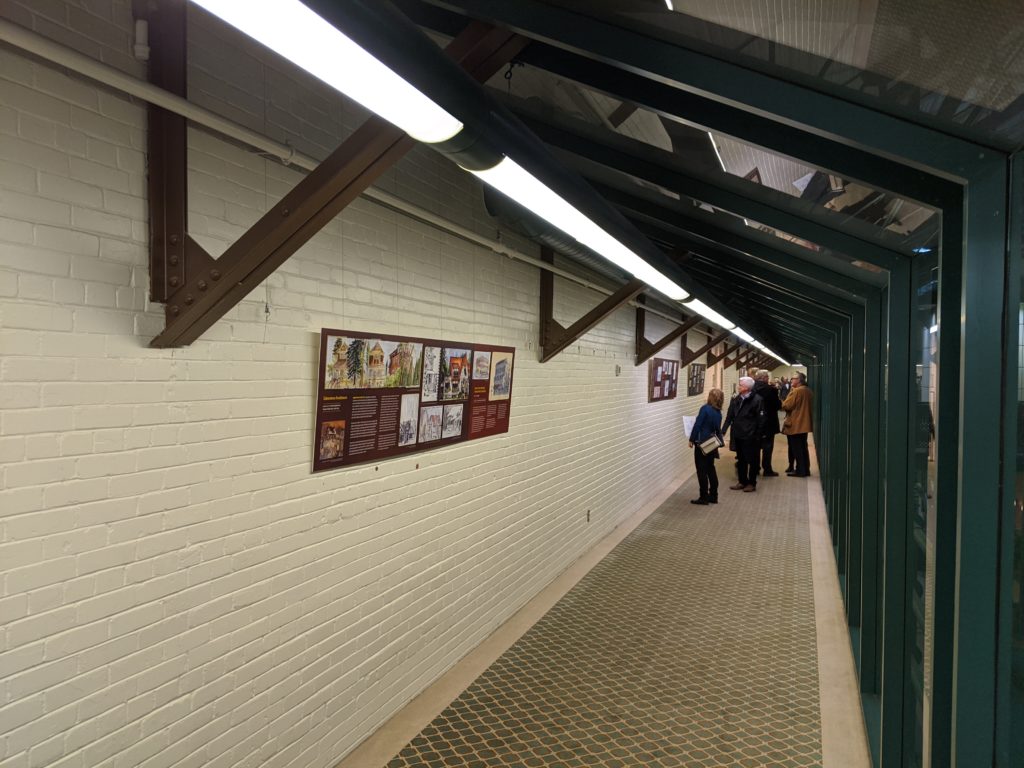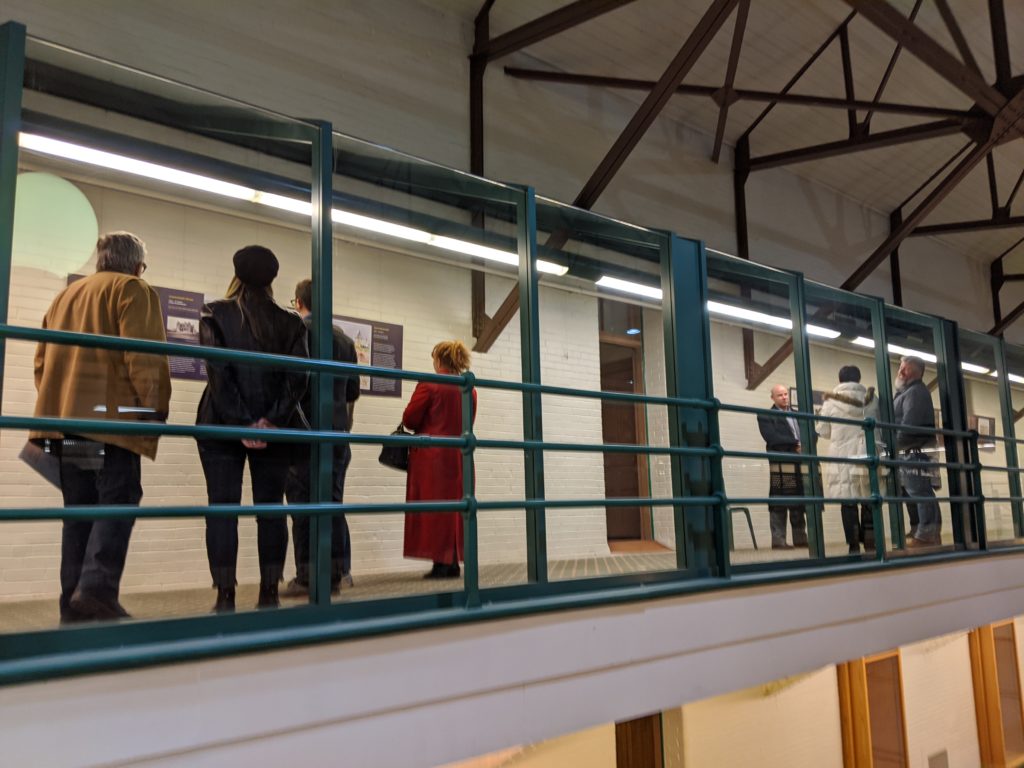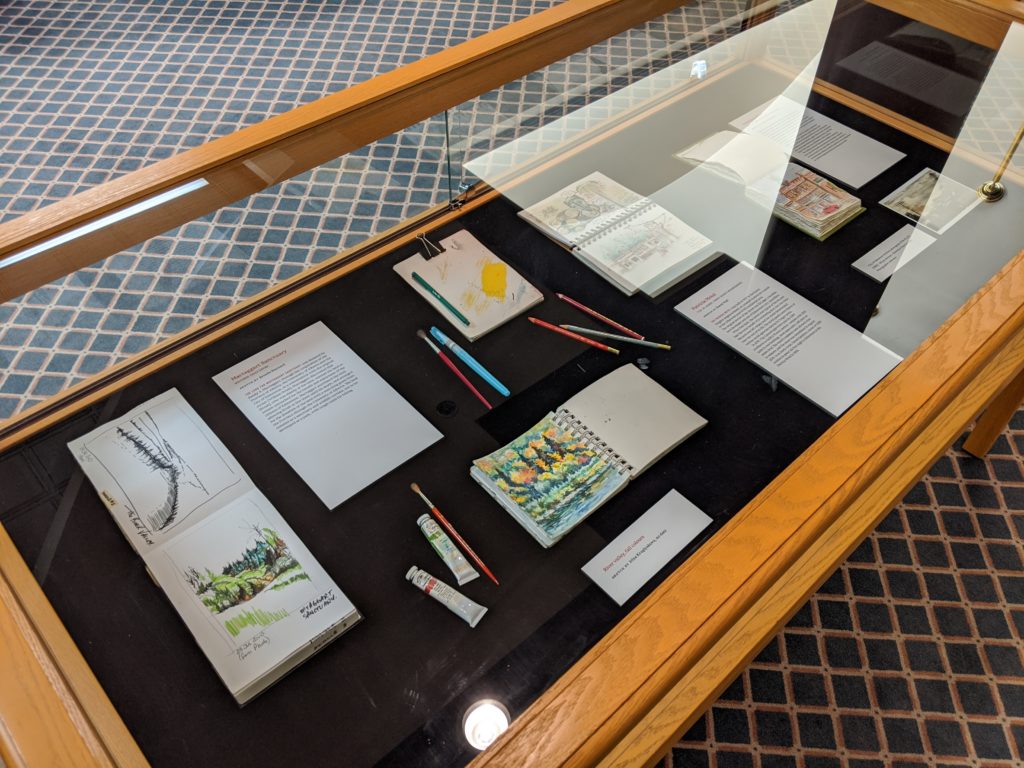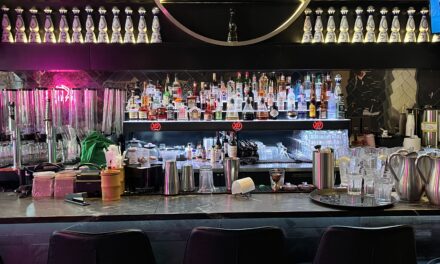An unusual exhibition viewing Edmonton’s architectural history through sketches and drawings

Review and photos by Kyle Monda
What do the Hotel McDonald, the High Level Bridge, and the Garneau Theatre have in common? All are important historical landmarks in Edmonton, representing unique architecture in our city, and have been recreated as art in Sketching History.
Curated by Edmonton’s current Historian Laureate, Marlena Wyman, Sketching History is an exhibition of sketches of Edmonton’s architectural landmarks created by her sketching group, Urban Sketchers Edmonton. The group is part of a broader international collective of urban sketchers that aim to tell stories and educate through on-location drawing. Sketching History incorporates the art depicting the buildings along with historical information pulled from the archives to teach visitors about Edmonton’s heritage.
The Prince of Wales Armouries in northwest Edmonton is the appropriately dramatic venue for the show, built in 1915 with red brick and castle-like elements. It is home to the City of Edmonton Archives and a variety of other local organizations. After walking through the front door, visitors are greeted by a sign that identifies where the Sketching History exhibits can be found throughout the facility. The main bulk of the exhibition is on the second floor along a glass-enclosed walkway that encircles the interior hall of the building.

Sketching might not be the first medium that comes to mind when one thinks about preserving architectural heritage, but after viewing the exhibition, it was certainly successful. The sketches captured the feeling of viewing the landmarks from the sidewalk more than a photograph could, as if you were remembering walking by years ago. It also had the effect of showing the buildings in their best light, rather than the unfortunate decrepit state many of them are in today.
There is plenty to learn from the exhibit, such as the fact that the iconic Hotel McDonald was almost demolished in 1983, or that the original Al Rashid Mosque, which now resides in Fort Edmonton Park, was the first mosque built in Canada, all the way back in 1938.
With hindsight, some of the information takes on an ironic tone, such as the suggestion that the University of Alberta “developed a clear aesthetic for its buildings” in 1915. Anyone who has visited campus since the 80s can see that commitment was definitely forgotten! The exhibit also includes a substantial amount of First Nation and Métis history, which is welcome considering that Indigenous histories are often overlooked in museum settings such as this one.
The sketching group welcomes members of all abilities, but their biographies reveal many of them come from professional art and design backgrounds, and this is clearly visible in the high quality of the sketches on display. The artists use plenty of different media, from watercolour to markers, and many of the pages are reproduced from notebooks or pages torn out from sketchbooks, giving them a charming low-fi frame.

In her curator statement, Wyman says that “Edmonton’s vital heritage architecture is disappearing, and along with it our city’s character and identity.” This is undoubtedly true, as despite only having lived in Edmonton for five years, I’ve noticed the neglect or outright demolition of many historical or otherwise unique landmarks. The exhibit succeeded in making me think more about how place and memory shapes my experiences in the city, and I hope Edmonton can work to preserve more of our built history in the future.
While overall I enjoyed the exhibit, I wish there were more originals of the sketches on display. There was a small number of originals in glass cases inside the Edmonton Archives reception and on the main floor, but the majority of the exhibit is prints of the sketches on display boards. This meant that some of the colour and detail from the sketches was lost.
However, the rich information and stories told by the accompanying text offset my disappointment in the lack of originals. I also wished the exhibit was organized to show a clear timeline of Edmonton’s architectural development rather than the somewhat random order it is presented in.
Given that the exhibit has been assembled from sketches by volunteers, the lack of cohesive story is understandable. Sketching History is definitely worth a visit for anyone who is interested in learning more about the history of our city, and since the price is free, there’s no reason not to take a look.
Sketching History can be visited whenever the City of Edmonton Archives are open. The site is accessible from Kingsway/Royal Alex LRT Station, and there is free parking in front of the Prince of Wales Armouries Heritage Centre (10440 108 Ave NW). The exhibit runs until December 2020.


